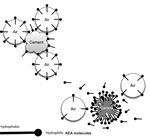 |
| The Tech Brief illustrates air entraining admixtures’ (AEA) limitations in the presence of unburned Class C or Class F fly ash carbon. As long-chain polymers, AEA have hydrophilic (attracting) and hydrophobic (resisting) ends, and are shown adsorbed on cement and stabilizing air bubbles (top) and carbon particles (bottom), where they are unable to stabilize air bubbles. |
A new Federal Highway Administration Tech Brief cites benefits and drawbacks of fly ash, slag cement, silica fume and natural or alternative pozzolans for transportation structure-grade concrete. “Supplementary Cementitious Materials — Best Practices for Concrete Pavements” (FHWA-HIF-16-001) outlines how agencies overseeing road construction and maintenance confront increasing service demands on concrete structures, expectations for reduced environmental impact, plus lower initial and lifecycle costs.
The seven-page Tech Brief discusses hydraulic and pozzolanic activity; Class F and Class C fly ash, slag cement and silica fume chemistry, specifications and performance characteristics; plus, ternary mixtures, where two or more SCM or binder materials join ordinary portland cement in concrete mix designs. It also examines how availability issues of the main SCM are opening the door to a) natural pozzolans, including some diatomaceous earths, opaline cherts and shales, tuffs and volcanic ashes, pumicite, plus various calcined clays and shales; and b) alternative SCM, defined as inorganic materials that react, pozzolanically or hydraulically, and contribute to concrete strength, durability and workability, but do not meet ASTM or AASHTO specifications for conventional SCM.
“Supplementary Cementitious Materials — Best Practices for Concrete Pavements” was published with oversight of FHWA Concrete Pavement Engineer Sam Tyson, P.E., and authored by Michigan Technological University Professor Lawrence Sutter. A pdf can be obtained from the Materials & Construction Technology/Concrete section at www.fhwa.dot.gov/pavement.
| MIXTURE PROPERTIES, SUPPLEMENTARY CEMENTITIOUS MATERIAL EFFECT |
 |
| Citing Portland Cement Association’s Design & Control of Concrete Mixtures, Tech Brief author Lawrence Sutter charts properties the main supplementary cementitious materials impart in fresh concrete, + and – indicating increase and decrease, 0 no change and < > varying effect depending upon material characteristics or replacement level. |
